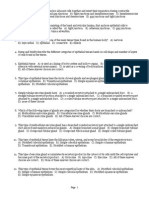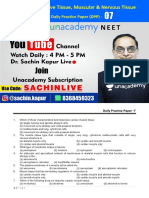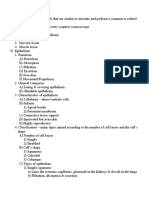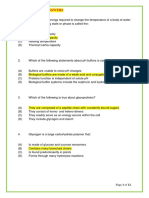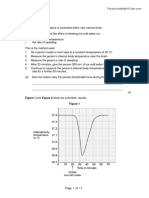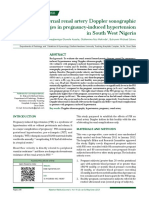Unit:-II Chapter-6. Animal Tissue: Important Points
Unit:-II Chapter-6. Animal Tissue: Important Points
Uploaded by
Chandan KumarCopyright:
Available Formats
Unit:-II Chapter-6. Animal Tissue: Important Points
Unit:-II Chapter-6. Animal Tissue: Important Points
Uploaded by
Chandan KumarOriginal Description:
Original Title
Copyright
Available Formats
Share this document
Did you find this document useful?
Is this content inappropriate?
Copyright:
Available Formats
Unit:-II Chapter-6. Animal Tissue: Important Points
Unit:-II Chapter-6. Animal Tissue: Important Points
Uploaded by
Chandan KumarCopyright:
Available Formats
Questionbank Biology
Unit:- II
Chapter-6. Animal Tissue
IMPORTANT POINTS
Tissue is the group of cells having similar structure & function. Animals contain 4 basic types of
tissues which are :- epithelial tissue, connective tissue, muscular tissue and nervous tissue. Epithelial
tissue can be derived from any of the three germinal layers. Epithelial tissues are of different types such
as : Squamous, cuboidal, columnar, ciliated, pseudo-stratified, stratified, and transitional.
Functions of epithelial tissue : Protection, secretion & absroption. There are 3 types of connective
tissues which are differentiated on the basis of extracellular material. Secreted by cells themselves. (a)
Connective tissue proper- (soft jelly like matrix with fibres) - are of five types : areolar, adipose, white
fibrous, tendon and legament.
(b) Skeletal tissue (Supportive connective tissue) includes cartilage and bones which form the
endoskeleton of the vertebrate body. The Cartilages are classified in to four group : Hyaline, white
fibrous, yellow elastic fibro cartilage and calicified cartilage.
(c) Blood (fluid connective tissue) is a fibre-free fluid extra cellular matrix.
It is a mobile connective tissue (Vascular/Fluid tissue). It is composed of plasma, blood cells and
blood platlets. It is a opaque trubid fluid.
Blood cells are erythrocytes and Leucocytes. There are five types of leucocytes : neutrophils,
eosinophils, basophils, monocytes and lymphocytes.
WBCs are colourless, nucleated found in blood (and lymph). Which are devoid of haemoglobin.
They are capable of coming out of blood capillaries through the process of diapendesis. (i. e. Greek
Word - diapendesis - leaping through)
(d) Mascular tissue (mostly mesodermal origin) is made up of elongated and contractive cells :
called muscles cells or myocytes.
There are three types of Muscular tissue : Skeletal muscle (striated), non striated and cardiac,
. Myoglobin - Muscle haemoglobin
. Myoblasts - Muscle forming cells.
. Myology : study of all aspects of muscles & accessory structures .
(e) The nervous tissue it is composed of two types of cells - (a) neurons : (Nerve cells) are
structural & functional unit, they transmit nerve impulses, (b) neuroglia. Neuron has one or more processes
extending from it . (i) Axon - carries impulses away from the cell body.
(ii) dendrites (G.K. dendron tree) take nerve impulse to the cell body.
On the basis of number of processes, neurons are : unipolar, bipolar & multipolar.
The nerve fibres may be surrounded by two concentric sheath. The inner is known as medullary
or myelin sheath.
Myelin is secreted by schwann cells in peripheral nerve fibes and oligodendrocytes in central
Nervons system.
48
Questionbank Biology
Schwann cells form the outer sheath called neurilema (GK. neuron- nerve, lemna-skin).
There is a physical gap between the nerve ending of axon and dendrites called synapse.
For the given options select the correct options (a, b, c, d) each carries one mark.
1.
Which of the following structure are made of several layer's of cells :(A) Ciliated epithelium
(B) Stratified epithelium
(C) Cuboidal epithelium
(D) Columnar epithelium
2.
Which simple epithelium tissue cells are square in vertical sections and Polygonal in horizontal section
(A) Columnar epithelium
(B) Squamous epithelium
(C) Cuboidal epithelium
(D) Ciliated epithelium
3.
Which of the following structure is not covered by epithelial tissue :(A) Blood vessels
(B) Digestive gland
(C) Skin
(D) Cartilage
4.
Which type of epithelium is present in the inner lining of large bronchi :(A) Squamous epithelium
(B) Pseudo - stratified epithelium
(C) Cuboidal epithelium
(D) Columnar epithelium
5.
Which of the following is arranged in a single layer :(A) Stratified epithelium
(B) Pseudo-stratified epithelium
(C) Ciliated epithelium
(D) Transitional epithelium
6.
Which tissue is located in uterine tube and proximal tube of kidneys respectively :(A) Columnar epithelium, Cuboidal epithelium
(B) Ciliated epithelium, columnar epithelium
(C) Ciliated epithelium, Cuboidal epithelium
(D) Cuboidal epithelium, ciliated epithelium
7.
Which of the following is a function of cuboidal epithelium :(A) Participate in secretion and excretion
(B) Helps to remove mucus from trachea
(C) To move mucus in a specific direction
(D) Protect inner tissue cells
8.
Name the structure arranged on basement membrane in compound epithelium :(A) Malpighian Corpuscle
(B) Malpighian tubule
(C) Germinative layer
(D) Malpighian body
9.
Which tissue occurs with in the passages of the excretory organs :(A) Ciliated Stratified epithelium
(B) Squamous Stratified epithelium
(C) Transitional epithelium
(D) Cuboidal Stratified epithelium
10. When the surface cells of stratified epithelium contain insoluble protein (Keratin) the tissue is called :(A) Stratified Squamous Keratinised
(B) Stratified Ciliated Keratinised
(C) Stratified Cuboidal Keratinised
(D) Stratified Columnar Keratinised
11. Name of a structure formed of collagen protien :(A) Yellow elastic
(B) White fibres
(C) Yellow fibre
(D) White fibrous
12. Which cells of areolar tissue are able to move and ingest foreign particles
(A) Fibroblast
(B) Mast cells
(C) Histocytes
(D) All above
49
Questionbank Biology
13.
14.
15.
16.
17.
18.
19.
20.
21.
22.
23.
24.
25.
26.
Which of the following is not a component of connective tissue proper .
(A) Adipose tissue
(B) Tendon
(C) Cartilage
(D) Ligament
Which of the following is not a component of Skeletal connective tissue :(A) Compact bone
(B) White-fibro cartilage
(C) Calcified cartilage (D) Areolar tissue
What is Synthesized by fibroblast
(A) Collagen
(B) Elastin
(C) (A) and (B)
(D) (A) or (B)
Which connective tissue proper is made up of two types of fibre and cells :(A) Tendon
(B) White fibrous tissue
(C) Ligament
(D) Areolar tissue
Which of the following tissue in normally found in tendon .
(A) Hyaline cartiage
(B) White fibrous tissue
(C) Ligament
(D) Areolar tissue
It connects the bones joints and holds them in position :(A) Tendon
(B) While elastic cartilage
(C) Ligament
(D) (B) and (C) both
Give examples of elastic bond
(A) Tendon
(B) Cartilage
(C) Ligament
(D) (B) and (C) both
Which of the following structure present in abundance in subcutaneous tissue :(A) Yellow elastic tissue (B) Adipose tissue
(C) White fibrous tissue
(D) Tendon
It is composed of bundles of collagen fibers :(A) Tendon
(B) White-fibro cartilage
(C) Hyaline cartilage
(D) White fibrous tissue
Who synthesized elastin protein
(A) Fibroblasts
(B) Adipose cell
(C) Phagocytic cell
(D) Mast cells
Which of the following structure is seen in the joints between skull bones :(A) Yellow elastic tissue (B) Cellular Cartilage
(C) White Fibrous tissue (D) Tendon
Which Structure is able to move in areolar tissue
(A) Adipose cell
(B) Phagocytic cell
(C) Fibroblasts
(D) Mast cell
Name the connective tissue present in larynx
(A) White fibrous cartilage
(B) Hyaline cartilage
(C) Areolar tissue
(D) Yellow elastic cartilage
Which connective tissue is found in epiglottis :(A) Yellow elastic cartilage
(B) Calcified cartilage
(C) Areolar tissue
(D) White fibrous tissue
50
Questionbank Biology
27.
28.
29.
30.
31.
32.
33.
34.
35.
36.
37.
38.
39.
40.
41.
A Structure having blood vessels in hyaline cartilage is :(A) Matrix
(B) Perichondrium
(C) Lacunae
(D) Chondroblasts
In which of the following yellow elastic cartilage is observed :(A) Tip of nose
(B) Ear pinna
(C) Epiglottis
(D) all above
Which of the following characteristics observed in yellow elastic cartilage :
(A) It has elastin
(B) Its matrix is homogeneous and translucent
(C) A few flat and elongated fibroblast cells lay between the fibre bundles.
(D) Cell are ovoid in shape and are surrounded by matrix.
Matrix of bone is composed of protein called
(A) Myosin
(B) Ossein
(C) Elastin
(D) Actin
In the centre of bone there is a narrow cavity it contains a tissue which :(A) is composed of adipose
(B) is yellow in colour
(C) Possess blood vessels
(D) all above
Which of the following structure is not included in blood cells
(A) Fibrinogen
(B) Lymphocytes
(C) Basophils
(D) Erythrocytes
Which is metabolic waste product of blood :(A) Fibrinogen
(B) carbon dioxide
(C) Lysine
(D) Immunoglobulin
What is the number of RBCs per cubic mililiter blood of adult made under normal condition .
(A) 41,00,000 to 60,00,000
(B) 7.5 3.5 x 103
(C) 39 to 55 x 1010
(D) 39,00,000 to 55,00,000
Which structure of blood is nucleated?
(A) Erythrocytes
(B) Leucocytes
(C) Bloood platlets
(D) Above all
Nucleus of which leucocytes have many lobe :(A) Eosinophils
(B) Neutrophils
(C) Basophils
(D) Monocytes
The darker bands in muscle fibre is called
(A) H - bands
(B) A - bands
(C) Z - bands
(D) I - bands
Which muscle tissue is mononucleate having granular sarcoplasm around its nucleus :(A) Smooth muscle
(B) Voluntary muscle tissue
(C) Cardiac muscle
(D) Skeletal muscle tissue
The lighter bands in muscles fiber is called :(A) I - bands
(B) H - bands
(C) Z - bands
(D) A - bands
A structure formed by enveloped of schwann's cells
(A) Nodes of Ranvier (B) Neurilemma
(C) Myelin Sheath
(D) (A) and (C) both
Cell body of which neuron giving rise to both dendrite and axonal branches.
(A) Unipolar neuron
(B) Multipolar neuron (C) Bipolar neuron
(D) All the above
51
Questionbank Biology
42.
43.
44.
45.
46.
47.
48.
49.
50.
51.
52.
Which structure is indicated by each myelinated nerve fibre.
(A) Neurilemma
(B) Constritions at regular intervals called nodes of ranvier
(C) Neurotransmitters (D) Synapes
Directions : In the following questions there are two statements; Assertion (A) and Reason (R):
(A) Both A and R are true and R is correct explanation ofA.
(B) Both A and R are true but R is not correct explanation of A.
(C) A is true and R is wrong.
(D) A is wrong and R is true.
A : Squamous epithelium protect the under lying tissue.
R : Outer most layer of skin of frog made up of squamous epithelium.
(A)
(B)
(C)
(D)
A : Thickness of skin layer is maintained.
R : In compound epithelium, layer rested on basement membrane shows power of cell division.
(A)
(B)
(C)
(D)
A : Mast cells are found in areolar tissue.
R : Mast cells produces heparin, histamine etc.
(A)
(B)
(C)
(D)
A : Cartilage bond connects the joints.
R : Matrix of cartilage is dense.
(A)
(B)
(C)
(D)
A : Yellow elastin cartilage has elastin.
R : Whie fibrous cartilage has bundles of collagen, fibres
(A)
(B)
(C)
(D)
A : Blood has properties of clotting
R : Blood has plasma protein fibrinogen.
(A)
(B)
(C)
(D)
A : Muscle fibre of skeletal muscle is multi nucleate.
R : In each animals muscle fibres are attached to bones by tendons.
(A)
(B)
(C)
(D)
A : Thick and thin filaments overlap for some distance within the A band
R : Thin Filaments slides over thick filaments
(A)
(B)
(C)
(D)
Which pair of structures distinguishes a nerve cell from other cells.
(A) Vacuole and fibres
(B) Nucleus and mitochondria
(C) Perikaryon and dendrites
(D) Flagellum and medullary sheath
Transitional epithelium occurs in :
(MHTCET 2008)
(A) Blood vessels
(B) Trachea
(C) Kidney
(D) Ureter/urinary bladder
52
Questionbank Biology
53.
54.
55.
56.
57.
58.
59.
60.
61.
62.
63.
The study of tissues is knows as :
(MPPMT 2010)
(A) Physiology
(B) Ecology
(C) Histology
(D) Anatomy
Find out the wrong match :
(Kerala 2010)
(A) Eosinophils
Allergic response
(B) Basophils
Secrete histamine and serotonin
(C) Monocytes
Secrete heparin
(D) Lymphocytes
Immune response
The outer covering of cartilage is called.
(WB 2010)
(A) Peritoneum
(B) Periosteum
(C) Endosteum
(D) Perichondrium
Skin is :
(CPMT 2010)
(A) Cubiodal epithelium
(B) Stratified epithelium
(C) Coloumnar epithelium
(D) Pseudostratified epithelumn
Match the animals listed in column-I to blood listed in column-II.
(KCET 2010)
Column-I
Column-II
(P) Man
(i) Plasma and cells are colourless
(Q) Earth worm
(ii) Plasma colourless and nucleated RBC
(R) Cockroach
(iii) Plasma colourless and enucleated RBC
(S) Frog
(iv) Plasma red and nucleated colourless RBC
(v) Plasma and RBS have haemoglobin
(A) (P-iii), (Q-iv), (R-i), (S-ii)
(B) (P-iv), (Q-v), (R-iii), (S-ii)
(C) (P-i), (Q-iv), (R-ii), (S-iii)
(D) (P-v), (Q-iii), (R-i), (S-iv)
Matrix of bone and cartilage can be distinguished by the presence of :
(Orrisa 2010)
(A) Lacuma
(B) Chromatophares
(C) Haversian canals
(D) Adipose cells
Which type of tissue forms glands :
(MPPMT 2010)
(A) Epithelial
(B) Muscular
(C) Nervous
(D) Connective
Which of the following blood cells help in blood coagulation.
(Orrisa 2010)
(A) RBCs
(B) Lymphocytes
(C) Thrombocytes
(D) Basophils
Fibroblasts macrophages and mast cells are present in :
(Kerala 2010)
(A) Cartilage tissue
(B) Areolar tissue
(C) Adipose tissue
(D) Glandular epithelium
Which type of epithelium is involved in a function to move particles or mucus in specific direction :
(HPPMT 2010)
(A) Squamous epithelium (B) Cuboidal epithelium (C) Columnar epithelium (D) Ciliatal epithelium
Which of these is not found in connective tissue :
(MPPMT 2010)
(A) Collagen fibres
(B) Basement membrane(C) Hyaluronic acid
(D) Fluid
53
Questionbank Biology
64.
68.
Multi-lobed nucleus and granular cytoplasm are characteristics of which of the WBCs :
(Orissa 2010)
(A) Neutrophils
(B) Monocytes
(C) Lymphocytes
(D) Eosinophils
Which one of the following plasma proteins is involved in the coagulation of blood. (CBSE 2011)
(A) globulin
(B) Fibrinogen
(C) albumin
(D) Serum amylase
Which of the following is not a connecting tissue. (CPMT 2010)
(A) Blood
(B) bone
(C) Lymph
(D) Nerve
The ciliated columnar epithelial cells in humans are knows to occur in.
(CBSE 2011)
(A) Bile duct and oesophagus
(B) Fallopian tubes and urethra
(C) Eustachian tube and stomach lining
(D) Bronchioles and fallopian tubes
Which of the following is correct for (1), (2), (3) lebelled in the given diagram ?
69.
(A) (1) Nucleus, (2) Basment membrane, (3) Free polygonal surface
(B) (1) Free polygonal surface, (2) Basement membranme, (3) Nucleus
(C) (1) Nucleus, (2) Free polygonal surface, (3) Basement membrane
(D) (1) Basement membrane, (2) Nucleus, (3) Free polygonal surface
Which of the following is correct for (1), (2), (3) and (4) in the given diagram ?
65.
66.
67.
(A) (1) Matrix (2) Chondrocyte (3) Lacunae (4) Collagen fibre
(B) (1) Lacunae (2) Matrix (3) Collagen fibre (4) Chondrocyte
(C) (1) Chondrocyte (2) Matrix (3) Collagen fibre (4) Lacunae
(D) (1) Collangen fibre (2) Lacunae (3) Chondrocyte (4) Matrix
54
Questionbank Biology
70.
Which of the following is correct for (1), (2) and (3) in the given diagram ?
71.
(A) (1) Lecunae (2) Chondrin Matrix (3) Chondrocytes
(B) (1) Chondrocytes (2) Lecunae (3) Chondrin Matrix
(C) (1) Chondrocytes (2) Lecunae (3) Chondrin Matrix
(D) (1) Chondrin matrix (2) Chondrocytes (3) Lecunae
Which of the following is correct for (1), (2), (3) in the given diagram ?
72.
(A) (1) Sarcoplasm (2) Sarcolema (3) Nucleus
(B) (1) Nucleus (2) Sarcoplasma (3) Sarcolema
(C) (1) Sarcolema (2) Nucleus (3) Sacroplasm
(D) (1) Sarcoplasm (2) Sarcolema (3) Nucleus
In the following diagram the thin filament is made up of.
(A) Only myosin
(C) H-line, troponin
(B) Actin, tropomyosin, troponin
(D) Myosin, actin and tropomyosin
55
Questionbank Biology
73.
Which of the following is correct for (1), (2), (3) in the given diagram ?
74.
(A) (1) Basal granule (2) Supporting cells (3) Mucus secreting cells
(B) (1) Supporting cells (2) Mucus secreting cell (3) Basal granule
(C) (1) Supporting cells (2) Basal granule (3) Mucus secreting cell
(D) (1) Mucus secreting cell (2) Supporting cells (3) Basal granule
Write location of the following diagram.
75.
(A) Gall blader
(B) Lungs
(C) Thyroid gland
(D) Uterine tube
In the diagram of the section of bone tissue given below, certain parts have been indicated by
alphabets, choose the answer in which these alphabets have been correctly matched with the parts
which they indicate.
(A) A = Interstitial lamellae, B = Laemaellae with osteocytes, C = Blood vessels, D = Nerve,
E = Canaliculi, F = Naversian canal, G = Lamellae
56
Questionbank Biology
76.
77.
(B) A = Interstitial lamellae, B = Haversian system, C = Concentric lamellae, D = Cacune with bone
cells, E = Matrix, F = Haversian canal, G = Canaliculi
(C) A = Interstitial lamellae, B = Osteocytes, C = Nerve, D = Blood vessels, E = Canaliculi, F =
Haversian system, G = Lamellae
(D) A = Interstitial lamellae, B = Osteocytes, C = Nerve, D = Blood vessles, E = Lamellae, F =
Haversian canal, G = Canaliculi
Which of the following is correct for (1), (2), (3) in the given diagram ?
(A) (1) Nucleus (2) Bands (dics) (3) Intercalated disc
(B) (1) Bands (disc) (2) Nucleus (3) Intercalated disc
(C) (1) Nucleus (2) Intercalated disc (3) Bands (discs)
(D) (1) Intercalated disc (2) Bands (discs) (3) Nucleus
Which of the following is correct for (1), (2) and (3) in the given diagram ?
(A) (1) Neuroaxon (2) Myelin sheath (3) Dendron
(B) (1) Myelin sheath (2) Neuroaxon (3) Dendron
(C) (1) Dendron (2) Neuroaxon (3) Myelin sheath
(D) (1) Myelin sheath (2) Dendron (3) Neuroaxon
57
Questionbank Biology
78.
79.
Which of the following is correct for (1), (2) and (3) in the given diagram ?
(A) (1) Elastic fibre (2) Lecunae (3) Matrix (4) Chondrocytes
(B) (1) Matrix (2) Chondrocytes (3) Lecunae (4) Elastic fibre
(C) (1) Chondrocytes (2) Matrix (3) Elastic fibre (4) Lecunae
(D) (1) Lecunae (2) Elastic fibre (3) Matrix (4) Chondrocytes
Which tissue indicated by given diagram ?
(A) Calcified cartilage (B) Hyaline cartilage
(C) White fibre cartilage (D) Yellow elastic cartilage
ANSWER KEY
1. (B)
5. (A)
9. (D)
13. (C)
17. (B)
21. (A)
25. (B)
29. (A)
33. (B)
37. (B)
41. (B)
45. (B)
49. (C)
53. (C)
57. (A)
61. (B)
65. (B)
69. (D)
73. (C)
77. (C)
2. (C)
6. (C)
10. (A)
14. (D)
18. (C)
22. (A)
26. (A)
30. (B)
34. (A)
38. (A)
42. (B)
46. (D)
50. (B)
54. (C)
58. (C)
62. (D)
66. (D)
70. (C)
74. (D)
78. (A)
3. (C)
7. (A)
11. (B)
15. (C)
19. (A)
23. (B)
27. (B)
31. (D)
35. (B)
39. (A)
43. (A)
47. (B)
51. (C)
55. (D)
59. (A)
63. (B)
67. (D)
71. (A)
75. (D)
79. (D)
58
4. (B)
8. (C)
12. (C)
16. (D)
20. (B)
24. (B)
28. (D)
32. (A)
36. (B)
40. (B)
44. (A)
48. (A)
52. (D)
56. (D)
60. (C)
64. (A)
68. (C)
72. (D)
76. (D)
You might also like
- Post TestDocument9 pagesPost TestPradnya Paramitha100% (3)
- Midterm Exams - AnatomyDocument9 pagesMidterm Exams - AnatomyBing580% (1)
- BoardVitals USMLEDocument2 pagesBoardVitals USMLEChandan KumarNo ratings yet
- Chapter Notes - Control and Coordination - Class 10 Science - PANTOMATHDocument16 pagesChapter Notes - Control and Coordination - Class 10 Science - PANTOMATHsourav982380% (5)
- Neet Structural Organisation in Animals Important QuestionsDocument18 pagesNeet Structural Organisation in Animals Important QuestionsARKA NEET BIOLOGYNo ratings yet
- Ch. 4 Student Packet (ANP)Document7 pagesCh. 4 Student Packet (ANP)Alex ZhangNo ratings yet
- Soalan Srtuktur & Fungsi TisuDocument21 pagesSoalan Srtuktur & Fungsi TisualiasLiew100% (1)
- Tissues 1 6 Ws With Key Animal Tissues Epithelial Tissue WsDocument11 pagesTissues 1 6 Ws With Key Animal Tissues Epithelial Tissue Wsvelammal kolapakkamNo ratings yet
- Histology Practice PracticalDocument38 pagesHistology Practice PracticalDeep Patel88% (8)
- Daily Practice Test-19 (Zoology) Questions: Fluid Connective Tissue, Muscular and Nervous TissueDocument3 pagesDaily Practice Test-19 (Zoology) Questions: Fluid Connective Tissue, Muscular and Nervous TissueSumathiNo ratings yet
- 1st Puc Neet Structural OrgDocument10 pages1st Puc Neet Structural OrgRajesh PrasadNo ratings yet
- Human Anatomy and PhysiologyDocument17 pagesHuman Anatomy and Physiology123khanshahrukh007100% (1)
- Biology PaperDocument3 pagesBiology Paperalok73612No ratings yet
- BIOLOGY WORKSHEET-ANIMAL TISSUES (Launch Pad 1)Document11 pagesBIOLOGY WORKSHEET-ANIMAL TISSUES (Launch Pad 1)RaashiNo ratings yet
- Chapter 1 - Plant Tissues and Animal TissuesDocument3 pagesChapter 1 - Plant Tissues and Animal TissuesSarang MangeNo ratings yet
- Structural 111 PDFDocument13 pagesStructural 111 PDFupadhayaya556No ratings yet
- Tissue Exam QnsDocument4 pagesTissue Exam Qnsvarsha thakur100% (1)
- NCERT Exemplar For Class 9 Science Chapter 6Document30 pagesNCERT Exemplar For Class 9 Science Chapter 6Vidhan PanwarNo ratings yet
- 3 PDFDocument20 pages3 PDFRose Augustin100% (1)
- ST - John'S School Greater Noida West Subject: Science CLASS IX: BIOLOGY (2020 - 21) Chapter - 6 Tissues (Answer Key - 2)Document6 pagesST - John'S School Greater Noida West Subject: Science CLASS IX: BIOLOGY (2020 - 21) Chapter - 6 Tissues (Answer Key - 2)India Tech with AstitvaNo ratings yet
- Structural Organization in AnimalDocument98 pagesStructural Organization in AnimalSwatija RoutNo ratings yet
- Biology 9th+class Animal+tissues CPP+ (BPD)Document2 pagesBiology 9th+class Animal+tissues CPP+ (BPD)Anusha PrincessNo ratings yet
- QB Tissue ChapterDocument16 pagesQB Tissue ChapterjackNo ratings yet
- Selina Solutions For Class 9 Biology Chapter 3 Tissues Plant and Animal TissuesDocument12 pagesSelina Solutions For Class 9 Biology Chapter 3 Tissues Plant and Animal TissuesleenaapNo ratings yet
- CLS Aipmt-15-16 XI Zoo Study-Package-1 SET-1 Chapter-2A PDFDocument16 pagesCLS Aipmt-15-16 XI Zoo Study-Package-1 SET-1 Chapter-2A PDFAnonymous Too8UuiNo ratings yet
- MCQDocument24 pagesMCQiqra jabeenNo ratings yet
- Fluid Connective Tissue, Muscular & Nervous Tissue: Daily Practice Paper (DPP)Document4 pagesFluid Connective Tissue, Muscular & Nervous Tissue: Daily Practice Paper (DPP)Sambhav shahNo ratings yet
- Tissues Grade 9 Important Topics RevisionDocument23 pagesTissues Grade 9 Important Topics RevisionArkodeep RayNo ratings yet
- Animal Tissues: Bit Bank Ix ClassDocument4 pagesAnimal Tissues: Bit Bank Ix ClassSurya RaoNo ratings yet
- Full Download Test Bank For Principles of Human Physiology, 5th Edition: Cindy L. Stanfield PDFDocument44 pagesFull Download Test Bank For Principles of Human Physiology, 5th Edition: Cindy L. Stanfield PDFzubbyfrijas100% (7)
- HistologyDocument19 pagesHistologyrand200507No ratings yet
- BIOLOGY DAY-13 ZOO-fDocument3 pagesBIOLOGY DAY-13 ZOO-fanvith srinivasNo ratings yet
- Ch. 3 Tissues Test: NameDocument5 pagesCh. 3 Tissues Test: Namestephanieyoung07No ratings yet
- Zoology QP 04-08-2023Document17 pagesZoology QP 04-08-2023sujathadevarakonda81No ratings yet
- Class 9 WS Animal TissueDocument3 pagesClass 9 WS Animal Tissuemidnightreveals2021No ratings yet
- Revision Test-1class Ix TissuesDocument5 pagesRevision Test-1class Ix TissuesAnwesh NayakNo ratings yet
- Tissues - McqsDocument5 pagesTissues - McqsDocumentSharer0% (1)
- 2115 Human Anatomy and PhysiologyDocument34 pages2115 Human Anatomy and PhysiologyMahesh ChouguleNo ratings yet
- Animal Tissues (MCQ)Document1 pageAnimal Tissues (MCQ)JP BRARNo ratings yet
- Practice TestDocument5 pagesPractice Testcarmen sandiegoNo ratings yet
- Animal TissueQuestionsDocument8 pagesAnimal TissueQuestionssingamroopaNo ratings yet
- Class 9th Science Test 24 FebruaryDocument11 pagesClass 9th Science Test 24 Februaryraonish001No ratings yet
- Neet Biology: Structural Organization of AnimalsDocument93 pagesNeet Biology: Structural Organization of AnimalsMonish KumarNo ratings yet
- TissuesDocument22 pagesTissuesmustafathegreat02No ratings yet
- Cell J Animal Tissues and FrogDocument10 pagesCell J Animal Tissues and Frogkhan.shifu999No ratings yet
- Second Semester - Musculoskeletal System: 1 Week Questions (Mcqs/Essay) & AnswersDocument36 pagesSecond Semester - Musculoskeletal System: 1 Week Questions (Mcqs/Essay) & AnswersHashim OmarNo ratings yet
- Histology and Embryology Mid-Semester Test For 2017grade MBBS Students (Examination Paper A)Document9 pagesHistology and Embryology Mid-Semester Test For 2017grade MBBS Students (Examination Paper A)Halfdan RasmussenNo ratings yet
- Students Worksheet I Topic: Epithelial Tissues and Connective Tissue GroupDocument5 pagesStudents Worksheet I Topic: Epithelial Tissues and Connective Tissue GroupSanta SaintNo ratings yet
- DocumentDocument20 pagesDocumentGajanan WarwatkarNo ratings yet
- Epithelial TissueDocument2 pagesEpithelial Tissueapi-295869261No ratings yet
- Test Question & AnswerDocument5 pagesTest Question & Answerrosalyn sugay100% (2)
- Bones MCQSDocument19 pagesBones MCQSAnime master100% (2)
- Quizch 04 TissuesqonlyproDocument16 pagesQuizch 04 Tissuesqonlyproapi-282601291No ratings yet
- Tissues NotesDocument4 pagesTissues NotesLeasxz ZxsaelNo ratings yet
- Anatomy and Physiology 1 Study QuestionsDocument43 pagesAnatomy and Physiology 1 Study QuestionsMombwe simonNo ratings yet
- Adobe Scan 25 Jul 2023Document2 pagesAdobe Scan 25 Jul 2023Koushikci KanjilalNo ratings yet
- Reviewer PrelimDocument19 pagesReviewer PrelimALPEREZ, GRACE LYN C.No ratings yet
- 7structural Organization in Animals PDFDocument8 pages7structural Organization in Animals PDFDharmendra SinghNo ratings yet
- HISTOLOGY - CorrectedDocument26 pagesHISTOLOGY - CorrectedLola KhatimNo ratings yet
- 2019 BMS1021 Practice Questions Answers PDFDocument12 pages2019 BMS1021 Practice Questions Answers PDFaskldhfdasjkNo ratings yet
- Final Revision HistoloyDocument20 pagesFinal Revision HistoloySandy AshrafNo ratings yet
- Screenshot 2023-05-30 at 23.49.23Document18 pagesScreenshot 2023-05-30 at 23.49.23shahedalamour3No ratings yet
- Advanced farriery knowledge: A study guide and AWCF theory course companionFrom EverandAdvanced farriery knowledge: A study guide and AWCF theory course companionNo ratings yet
- History Taking Amp Clinical Examination Pattern PDFDocument3 pagesHistory Taking Amp Clinical Examination Pattern PDFChandan KumarNo ratings yet
- Free Download Here: Arup Kumar Majhi Bedside Obstetrics PDFDocument2 pagesFree Download Here: Arup Kumar Majhi Bedside Obstetrics PDFChandan Kumar40% (5)
- Free Download Here: Arup Kumar Majhi Bedside Obstetrics PDFDocument2 pagesFree Download Here: Arup Kumar Majhi Bedside Obstetrics PDFChandan Kumar50% (2)
- C19 Pipeline Update Dec15Document11 pagesC19 Pipeline Update Dec15Chandan KumarNo ratings yet
- CV - Dr. Manish Mandal GISDocument3 pagesCV - Dr. Manish Mandal GISChandan KumarNo ratings yet
- USMLE Preparation Question BanksDocument3 pagesUSMLE Preparation Question BanksChandan KumarNo ratings yet
- Ulstermedj00133 0050bDocument1 pageUlstermedj00133 0050bChandan KumarNo ratings yet
- Meritlistv UGMACP2016Document6 pagesMeritlistv UGMACP2016Chandan Kumar0% (2)
- Data Highlights: The Scheduled Castes Census of India 2001: Andhra PradeshDocument4 pagesData Highlights: The Scheduled Castes Census of India 2001: Andhra PradeshChandan KumarNo ratings yet
- Ecg - Partea I - Mircea CintezaDocument16 pagesEcg - Partea I - Mircea CintezaAndrei CiobotaruNo ratings yet
- Cardiovascular Disorders ExamDocument13 pagesCardiovascular Disorders Exambobtaguba100% (1)
- Electrocardiographic Monitoring 2017Document72 pagesElectrocardiographic Monitoring 2017Mirela Marina BlajNo ratings yet
- Shock Comparison ChartDocument2 pagesShock Comparison Chartlinnaete88% (8)
- Jameson 2006Document28 pagesJameson 2006Александр ИвановNo ratings yet
- An Introduction To The Human Body: I. CompetenceDocument11 pagesAn Introduction To The Human Body: I. CompetenceMea DolautaNo ratings yet
- XBHA2103 Human Anatomy and Physiology CApr14 (RS) (M)Document335 pagesXBHA2103 Human Anatomy and Physiology CApr14 (RS) (M)FAEZAL HAZLY B. MOHD NAJIB STUDENT100% (2)
- PVD Prep U. Chapter 27Document5 pagesPVD Prep U. Chapter 27Monica JubaneNo ratings yet
- BSNURSE: NCP - HypertensionDocument3 pagesBSNURSE: NCP - Hypertensionmickey_beeNo ratings yet
- Profile of A NewbornDocument2 pagesProfile of A NewbornM.N MesaNo ratings yet
- Syndromes Suggestive of Ischemia or Infarction: EMS Assessment and Care and Hospital PreparationDocument1 pageSyndromes Suggestive of Ischemia or Infarction: EMS Assessment and Care and Hospital Preparationgusti angri angalanNo ratings yet
- Physioex Lab Report: Pre-Lab Quiz ResultsDocument5 pagesPhysioex Lab Report: Pre-Lab Quiz ResultsRasendria FirdiansyahNo ratings yet
- Physiology MCQ - BloodDocument4 pagesPhysiology MCQ - BloodMariam QureshiNo ratings yet
- Template - Grade 9 WorksheetDocument4 pagesTemplate - Grade 9 WorksheetRaymeishNo ratings yet
- All Steps Measured Incvs PBL (Stemi) @wusomDocument21 pagesAll Steps Measured Incvs PBL (Stemi) @wusomkamaluNo ratings yet
- Neurons Rhombomere Hindbrain Amphibians Reflex Electrical SynapsesDocument11 pagesNeurons Rhombomere Hindbrain Amphibians Reflex Electrical SynapsesNagy DóraNo ratings yet
- 1st Periodic Test P.E11Document2 pages1st Periodic Test P.E11Jay CervantesNo ratings yet
- Chest Pain FinalDocument17 pagesChest Pain FinalVarun R'MenonNo ratings yet
- NCERT Solutions For Class 11 Biology Chapter 6 Anatomy of Flowering PlantsDocument8 pagesNCERT Solutions For Class 11 Biology Chapter 6 Anatomy of Flowering PlantsyashNo ratings yet
- Manual Cardiologia y Cirugia CardiovascularDocument84 pagesManual Cardiologia y Cirugia CardiovascularAna Sylvia AguilarNo ratings yet
- Leaf Structure Amc 1Document24 pagesLeaf Structure Amc 1myatlaykhinNo ratings yet
- You Take My Breath AwayDocument26 pagesYou Take My Breath AwayAbigael CañazaresNo ratings yet
- 5.1 Homeostasis QPDocument11 pages5.1 Homeostasis QPMareeb ShahNo ratings yet
- Ecg 111029102429 Phpapp01Document103 pagesEcg 111029102429 Phpapp01Vickry WahidjiNo ratings yet
- Test Bank For Human Biology 11th Edition StarrDocument27 pagesTest Bank For Human Biology 11th Edition Starrjohnsmithysekamonit100% (36)
- PIH Renal Doppler Pregnancy - CutDocument4 pagesPIH Renal Doppler Pregnancy - CutAnonymous 9QxPDpNo ratings yet
- Postanesthetic Aldrete Recovery Score: Original Criteria Modified Criteria Point ValueDocument3 pagesPostanesthetic Aldrete Recovery Score: Original Criteria Modified Criteria Point ValueBonny ChristianNo ratings yet
- ANAPHY Lec Session #14 - SAS (Agdana, Nicole Ken)Document8 pagesANAPHY Lec Session #14 - SAS (Agdana, Nicole Ken)Nicole Ken AgdanaNo ratings yet






















